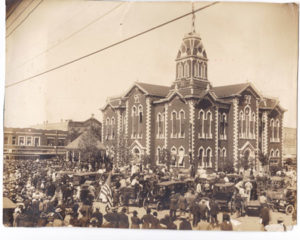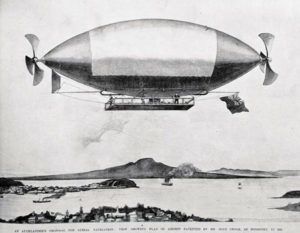
An estimated 5000 citizens gathered at the Hunt County Courthouse in Greenville, Texas on April 21, 1917. Instead of traditionally celebrating San Jacinto Day, when Texas won her independence from Mexico, the crowd eagerly listened to Governor James Ferguson and showed support for President Wilson’s war tactics. Note the enormous American flag on the flagpole atop the copula.
Daily newspapers often delight us, bring giggles and tears, and tear at our heartstrings. Such was April 1917. Normally spring brought news of baseball and track meets to Greenville and Hunt County. While these sports captured the readers’ attention, national and international news were at the forefront that year. On April 6 President Wilson asked Congress to declare war on Germany and Austria-Hungary. The whole world was at war, now the United States joined in the fray.
The Zimmerman Telegram a month earlier scared many Americans into the belief that war was inevitable. Patriotism sprang up like the first weeds of the season. Patriotic citizens purchased an American flag 25 feet by 15 feet to unfurl on a seventy-foot flagpole on the roof of the courthouse. Governor James E. Ferguson arrived on April 21, San Jacinto Day in Texas, to deliver the principal address at the flag raising ceremony. More than 5,000 people from all parts of Hunt County gathered on the courthouse lawn to hear the Governor and others give speeches in support of the President and the ideas he endorsed. A resolution pledging the support of citizens (remember only men could vote) to the President was adopted. The selective draft plan of raising an army was favored.
Earlier in the month a crowd of an estimated 5,000 people joined in a public celebration to honor the Hunt County Company of the National Guard. A donation of $250 was collected and given the men for unfurnished necessities. The local company had gained about fifty recruits in five days. At mid-month fifteen young men from Greenville enlisted in the US Navy and immediately left for Dallas to be assigned for training. One of the new enlistees was Cornelius E. Hall, an African American of Greenville. By the end of the month President Wilson and General Joffre of France indicated by the end of May National Guard troops would be on their way to France.
Such events were held in many parts of the country. However, in other places the war was not at all popular. Among other matters, Americans were encouraged to report any neighbors who were not enthusiastic about the war. The Great War was as divisive as any war.
But there was humor and good cheer in the air in April 1917. The folks at Commerce were tremendously enthusiastic about the Governor’s approval of Mayo’s College becoming East Texas Normal College.

Was this the flying machine Mrs. John Wells saw over her home in Commerce? She described it as flying rapidly over the campus of East Texas Normal College. Sighting such as this were quite frequent in the spring of 1897. But very few reports were found in 1917. See http://www.carolctaylor.com/wordpress/?p=634
for more about flying machines in Northeast Texas. (Gareth Shute: Airships)
A gentleman in Commerce decided to challenge a recent Supreme Court decision that the pool hall law was unconstitutional. He opened a pool hall in downtown Commerce with no problems.
The sheriff received reliable word that a possible bomb might blow up the cotton compress in Greenville. Extra deputies patrolled the area but no bombs were found.
And finally, Mrs. John Wells stated that about 5:35 on the morning of April 25 she saw a flying machine at not a great height traveling due north over the western part of Commerce. She described it as shaped like a canoe carrying three passengers flying rapidly over the college. It was broad daylight so there could be no mistake about it.
For more detailed events in April 1917 visit my FaceBook page at Carol Taylor. I’m the one standing by a Texas Historical Marker.
